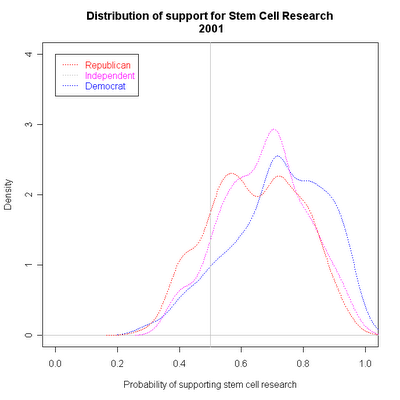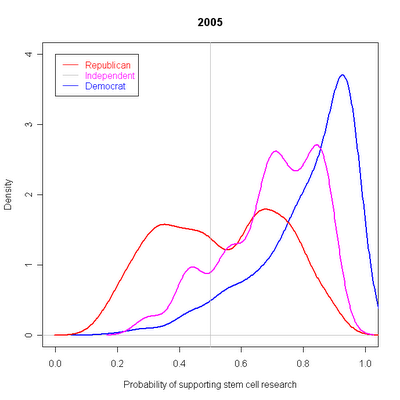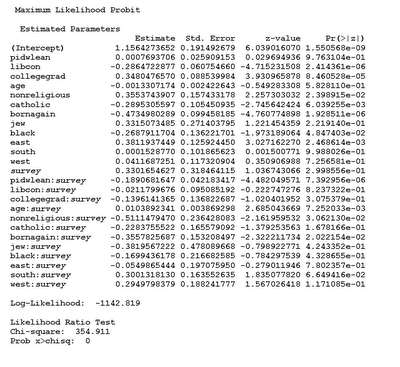

The Senate voted on Tuesday (July 18) to broaden the range of stem cell lines that would be eligible for federal funding. President Bush has indicated he plans to veto the legislation (passed last year by the House of Representatives). The House is expected to vote promptly on a possible veto override, but there is no expectation that such a vote will pass. The willingness of both houses of congress to pass such legislation in the face of a presidential veto threat is quite interesting. What are the public attitudes that set the stage for this vote?
ABC News and the Washington Post provide handy survey data with which to address this question. The ABC/WP poll asked a simple "do you support or oppose stem cell research" question in polls of 7/26-30/2001 and 6/2-5/2005. The first of these was taken before President Bush announced his limitation of federal funding for stem cell research to a few cell lines created before his decision, effectively banning federal support for the creation of new stem cell lines. (There is little polling available on stem cells in 2006. However, I think there is little reason to expect substantial change in opinion since 2005.)
The question wording is different between these questions, but the marginal distributions are all but identical. The question in 2001 was prefaced by a lengthy introduction to stem cells:
Sometimes fertility clinics produce extra ferilized eggs, also called embryos, that are not implanted in a woman's womb. These extra embryos either are discarded, or couples can donate them for use in medical research called stem-cell research.
Some people support stem-cell research, saying it's an important way to find treatments for many diseases. Other people oppose stem-cell research, saying it's wrong to use any human embryos for research purposes.
What about you--- do you support or oppose stem-cell research?
In contrast, the 2005 question simply asked, with no introduction:
Do you support or oppose embryonic stem cell research?Despite the differences in wording and a gap of four years, the two items produce remarkably similar readings of public support for stem cell research:
In 2001, 65.7% supported stem cell research, in 2005 it was 63.9%.
So one might be tempted to conclude that nothing had changed over this period. But a look at the data tells another story.
I pool the data from the two surveys in 2001 and 2005 and estimate the change in structure of support for stem cell research. The most powerful result is that party identification had absolutely no role in structuring opinion about stem cells in July of 2001. Whether we look at the simple percentages by party, or use a more sophisticated model controlling for several other variables, the simple fact is there is no discernable effect of partisanship in 2001. By 2005 this is dramatically different with Republicans much more likely to oppose stem cell research than Democrats.
Catholics and born-again believers became substantially more opposed to stem-cell research between 2001 and 2005. The non-religious population had been more supportive than average in 2001 but by 2005 no longer differed from "mainstream (non-evangelical) Christians. African-Americans who were skeptical in 2001 appear to have moved to open opposition by 2005. The only strong regional effect is that the northeast is the region most likely to support stem cell research. Age played no role in 2001 but became significantly and positively related to support in 2005. For the obsessive in the house, here are the estimated parameters of the model. Survey is coded 0 for 2001 and 1 for 2005 and is allowed to interact with all terms in the model. This effectively allows the fit to be independent between years.
The most striking thing about the second figure above is that the Republican party is indeed divided on this issue. The "right hump" in the figure betrays the possibility that Republicans are quite divided on this issue.

The top two figures show the magnitude of these changes. In 2001, there was little difference betwen the parties, and the three distributions clearly overlap far more than they differ. By 2005, the parties are far more differentiated, with approximately half of the Republican identifiers in the ABC/Washington Post poll opposing stem cell research while something close to 90% of Democrats support this research.
The top figure shows the distribution of probability of supporting stem cell research in 2001. The overlap of the party distributions is striking. Below that is the estimate based on interviews conducted in June 2005. The Democrats have moved stikingly to the right, that is into increased support for stem cell research. The Republicans have clearly shifted to lower probability of support, with an important increase in bi-modality. Independents are between these two extremes.
In the lower panel we see the problems facing Republican's on this issue. While there is a substantial anti-stem cell contingent in the Republican party, there is also a substantial group that resembles independents more than anything else. Indeed, the "right hump" of the Republican distribution could actually "blend" into the independent support for stem cells without much trouble (at least as we've measured things here.)
Meanwhile Democratic attitudes have become more homogeneous with strong support for stem cells. To be sure there is a long left tail to the Democrati distribution, but the vast majority of this distribution is to the right in the figure.
So the bottom line is that despite the seeming stability of the marginals, there has been considerable shifting of preferences within parties and in largely opposite directions.
In 2005, ABC also asked if respondents wanted to see federal funding extended or remain restricted acording to the Presidents previous policy. Here the results largely mirror the opinion on stem cell research more generally. There is considerable spread, and Republican bimodality.

The most powerful contributor to that bimodality is religion. Born again Christians are quite strongly opposed to stem cell research, and became even more opposed in 2005. Catholics also increased their opposition to stem cell research.
We can see the gross dynamics of opinion by using the model to estimate individual change over the four years between 2001 and 2005. The gist of the statistical model is to estimate the factors affecting support for stem cells in 2001 and use those parameters to estimate for 2005 respondents what we should expect their attitudes to have been in 2001. My two-stage auxiliary instrumental variables technique (2SAIV) shows that such a method can produce reliable inferences over time even without panel data, which interviews the same people.
What we see in the figure below is that Democrats almost all increased their support for stem cell research. Republicans, on the other hand, show more heterogeneity. SOME Republicans, between about .6 and .8 in probability of support in 2001, increased their support over the four years. In contrast, those at the lower tail of estimated support became dramatically more opposed, as did those towards the high end of support. Independents shifted more or less randomly, with little evidence of stong effects.

Democrats would appear to have a chance to split the Republican coalition between the two "humps" in the stem cell support distribution. Doing so would divide those who are already close to the independents in these data from those Republicans who could be labeled "extreme". The trick for Democrats is finding issues that reveal important divisions in the Republican party. On the issue of stem cells, it appears the Republicans themselves have brought up the opportunity.
Click here to go to Table of Contents